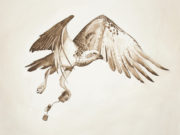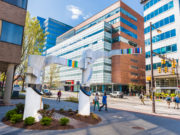In the Renaissance spirit of Leonardo da Vinci, the University City Science Center has embarked on a new, interdisciplinary collaboration between art and science. Angela McQuillan, curator at the University City Science Center’s Esther Klein Gallery, notes that these two spheres “have not always been as separate as we experience them in our society today.”
Under the Art + Science Residency, Philadelphia artist Orkan Telhan is observing experiments and shadowing scientists in the labs at Integral Molecular, a uCity Square-based biotechnology company.
The focus “is understanding how the perception of taste happens on the cellular level,” says Telhan, an associate professor at the University of Pennsylvania’s School of Design. “I am trying to [understand] how certain chemicals get ‘tasted’ differently across different animals like cats and humans.”
The subject is one that Telhan has explored before, notably with his projects “Bananaworks,” which explored the future of food and the evolution of taste, and “30-Day Microbial Simit Diet,” a representation of a diet based on traditional Turkish bread.
“I am interested in the future of food with respect to human consumption,” he says. “As we grow into massive numbers, what humans like to eat — or choose not to eat — drives animals or plants into extinction. Our culinary preferences, or what we call ‘taste,’ costs quite a bit of burden to nature. So I use my work to ask questions about where all of this is heading.
Art and science are both ways that humans have discovered to look at and understand the world. I think that the motivations behind each process are fundamentally the same, the differences lie in the tools and the approach.Angela McQuillan, Esther Klein Gallery
“Biotechnology is one of the most powerful tools we have to address these issues,” he continues. “My artworks use biotech to create provocations that can trigger discussions among the different stakeholders that are affected by human taste. I am interested in shaping public opinion so we can make more informed decisions.”
Ben Doranz, Integral’s president and CEO, sees the collaboration as a way to enhance innovation.
“Art and science are much closer than one might think, at least the discovery and research that we do,” he says. “Integral Molecular tackles some of the most difficult scientific questions and problems that exist and thinking ‘outside the box’ is a necessity for us to find answers and solutions. We welcome scientists — and anyone, including artists — that can help us think differently.”
McQuillan agrees.
“Art and science are both ways that humans have discovered to look at and understand the world,” she says. “I think that the motivations behind each process are fundamentally the same, the differences lie in the tools and the approach. In our current time of rapid technological advancement, scientists and artists can work together to address really important questions relating to biopolitics, bioethics, healthcare, environmental issues and even the definition of life itself.”
The residency is also a way to promote science and make it more accessible.
“The public face of science is sometimes obscured by other news or sometimes even distorted by headline-grabbing anomalies,” says Doranz. “We hope that this program helps explain what scientists do and why do they it in a much more visceral way.”
The pilot program (McQuillan hopes to make it permanent) is a natural for the Science Center.
“We have many companies doing cutting-edge research on our campus,” she says. “It just makes sense that we would also host cutting-edge artists.”
As for Telhan’s final work, it will take about a year to develop, based on the research conducted during the three-month residency. He predicts a visual component (physical artifacts and video) and a publication that explains the research process.
ELISE VIDER is news editor of Keystone Edge.
WRITER IN RESIDENCE is a partnership between the University City Science Center, Keystone Edge and Flying Kite Media that embeds a reporter on-site at Quorum, the Science Center’s clubhouse for entrepreneurs at 3711 Market Street. The resulting coverage will provide an inside look at the most intriguing companies, discoveries and technological innovations coming out of this essential Philadelphia institution.
Lead image: Recent work by Orkan Telhan, “30-day Microbial Simit Diet” / Photo credit: Engin Gercek


